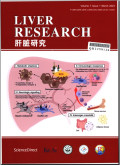摘要Endoplasmic reticulum(ER)stress occurs when ER homeostasis is perturbed with accumulation of unfolded/misfolded protein or calcium depletion.The unfolded protein response(UPR),comprising of inositol-requiring enzyme 1α(IRE1α),double-stranded RNA-dependent protein kinase(PKR)-like ER kinase(PERK)and activating transcription factor 6(ATF6)signaling pathways,is a protective cellular response activated by ER stress.However,UPR activation can also induce cell death upon persistent ER stress.The liver is susceptible to ER stress given its synthetic and other biological functions.Numerous studies from human liver samples and animal disease models have indicated a crucial role of ER stress and the UPR signaling pathways in the pathogenesis of liver diseases,including non-alcoholic fatty liver disease(NAFLD),alcoholic liver disease(ALD),alpha-1 antitrypsin(AAT)deficiency(AATD),cholestatic liver disease,drug-induced liver injury,ischemia/reperfusion(I/R)injury,viral hepatitis and hepatocel-lular carcinoma(HCC).Extensive investigations have demonstrated the potential underlying mechanisms of the induction of ER stress and the contribution of the UPR pathways during the development of the diseases.Moreover,ER stress and the UPR proteins and genes have become emerging therapeutic targets to treat liver diseases.
更多相关知识
- 浏览1
- 被引1
- 下载0

相似文献
- 中文期刊
- 外文期刊
- 学位论文
- 会议论文



 换一批
换一批 换一批
换一批




